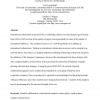Free Online Productivity Tools
i2Speak
i2Symbol
i2OCR
iTex2Img
iWeb2Print
iWeb2Shot
i2Type
iPdf2Split
iPdf2Merge
i2Bopomofo
i2Arabic
i2Style
i2Image
i2PDF
iLatex2Rtf
Sci2ools
JOI
2008
2008
International collaboration in science and the formation of a core group
International collaboration as measured by co-authorship relations on refereed papers grew linearly from 1990 to 2005 in terms of the number of papers, but exponentially in terms of the number of international addresses. This confirms Persson et al.'s (2004) hypothesis of an inflation in international collaboration. Patterns in international collaboration in science can be considered as network effects, since there is no political institution mediating relationships at that level except for the initiatives of the European Commission. Science at the international level shares features with other complex adaptive systems whose order arises from the interactions of hundreds of agents pursuing self-interested strategies. During the period 2000-2005, the network of global collaborations appears to have reinforced the formation of a core group of fourteen most cooperative countries. This core group can be expected to use knowledge from the global network with great efficiency, since th...
| Added | 13 Dec 2010 |
| Updated | 13 Dec 2010 |
| Type | Journal |
| Year | 2008 |
| Where | JOI |
| Authors | Loet Leydesdorff, Caroline S. Wagner |
Comments (0)

